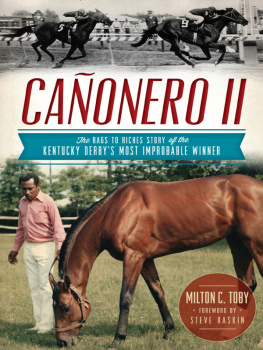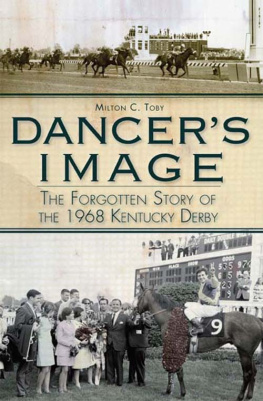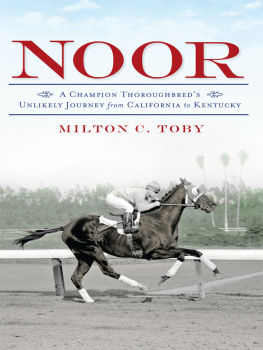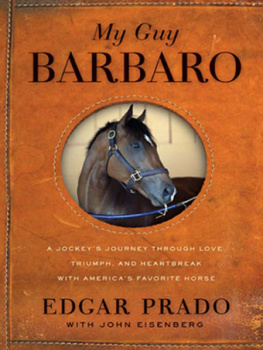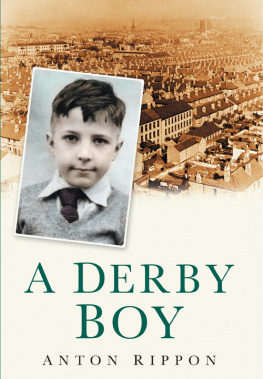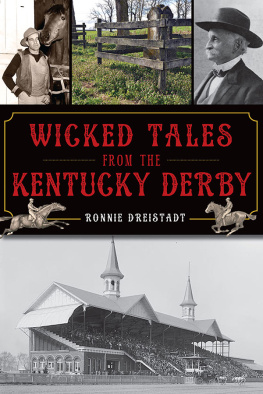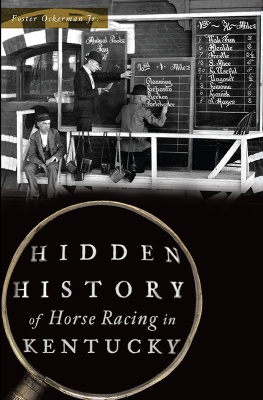

Published by The History Press
Charleston, SC 29403
www.historypress.net
Copyright 2014 by Milton C. Toby
All rights reserved
Front cover, bottom: Courtesy of Keeneland/Thoroughbred Times.
First published 2014
e-book edition 2014
ISBN 978.1.62584.503.0
Library of Congress Cataloging-in-Publication Data
Toby, Milton C.
Caonero II : the rags to riches story of the Kentucky Derbys most improbable winner / Milton C. Toby.
pages cm
Includes bibliographical references.
print edition ISBN 978-1-62619-047-4
1. Kentucky Derby. 2. Horse racing--Kentucky. 3. Thoroughbred horse. I. Title.
SF357.575.C36T63 2013
798.400976944--dc23
2013050129
Notice: The information in this book is true and complete to the best of our knowledge. It is offered without guarantee on the part of the author or The History Press. The author and The History Press disclaim all liability in connection with the use of this book.
All rights reserved. No part of this book may be reproduced or transmitted in any form whatsoever without prior written permission from the publisher except in the case of brief quotations embodied in critical articles and reviews.
CONTENTS
FOREWORD
It is a story that has been crying out to be told for over four decades, a story that no fiction writer could ever conceive.
It wasnt until I became a feature writer for the Daily Racing Form in 1991 that I embarked on the written journey of Caonero II, a horse whose story amazed me in 1971 and still amazes me today. As I kept gathering additional pieces to this incredible story, new revised features appeared in the DRF and then the Blood-Horse, where I have been senior correspondent for the past fifteen years. I was determined not to let the story of Caonero wither with the years.
With every word of this fairy tale came visions of a movie or a book, even in the form of an animated film or childrens book. One of my constant goals as a writer has been to tell the fairy tale side of Thoroughbred racing, the stories that strip away our hardened exteriors and reach into the core of our soul to make the Sport of Kings a magical place that sustains its energy from the implausible truth.
As my revised stories on Caonero continued to appear, eventually in my blog/column on Bloodhorse.com, there came constant requests to tell the story of Caonero in a book. But having written six books for the Blood-Horses publishing arm, Eclipse Press, and serving as contributing writer on several others, I simply did not have the time to devote to a story that was so close to my heart and would require even more time and extensive research than I was able to give it.
Finally, two years ago, I was contacted by producer Salomon Gill, a native of Venezuela, who was intent on making a major motion picture about Caonero, based in good part on my writings, complete with an introductory documentary and a talented team of top actors and filmmakers. I was asked to be part of that team, as consultant and as an actual character in the movie. Needless to say, I was flattered and overjoyed to hear that the story of Caonero was in such enthusiastic and skillful hands.
Then, recently, I was contacted by longtime racing writer Milt Toby, whose writings in Blood-Horse back in the 1970s when I was librarian for the Daily Racing Form and a fledgling freelance writer provided a good deal of my reading material. Milt had begun work on a Caonero book, much to my delight. Having already done a brilliant job on the much darker story of Dancers Image, Milt was the perfect person to embark on this monumental project. He had the experience of the times and the expertise to do the story justice. The Caonero story finally was going to be told, in written form as well as visually. And most importantly, it was going to be told by talented artists who have been touched and inspired by this story as much as I have.
The story you are about to read is about a crooked-legged horse of obscure parents who was sold for a paltry $1,200 and arrived in Venezuela with a split hoof and a bad case of worms. Turned over to trainer Juan Arias, who had grown up in the slums of Caracas, this unlikeliest of heroes embarked on arguably the most amazing journey in the annals of Thoroughbred racing, beginning with its flight to the United States on a plane filled with chickens and ducks and continuing through its breathtaking victories in the Kentucky Derby and Preakness. The ugly duckling that was considered a mockery in the United States after arriving in Kentucky had become a national hero in both South and North America and the pride of Spanish-speaking people from both continents.
As I concluded in my latest story, when Caonero died at Haras Tamanaco in 1981 after returning to Venezuela, the magnificent decade of the seventies was history, with Secretariat, Forego, Seattle Slew, Affirmed, Alydar and Spectacular Bid all stamping their place in the record books. But few remembered that it was Caonero that paved the way for these media stars.
By the time of his death, the cries of Viva Caonero had faded to a whisper, and the horse that had electrified the racing world, drawing the largest crowd in Belmont history, had slipped quietly back into the obscurity from which he came.
Caoneros Derby and Preakness trophies were given to La Rinconada Racetrack, but they were never exhibited anywhere. The statue of him that had been commissioned was never built. As the years pass by and a new, younger core of high-tech racing fans emerge with little grasp of history, the name of Caonero drifts deeper into memory, as do his amazing feats.
But after four decades, it is time to remember Caonero and a special time in racing when the entire sport was set ablaze by a horse they called the Caracas Cannonball.
You are now about to embark on this remarkable journey, thanks to Milt Toby and the passion and brilliant storytelling that exudes from every page. By the end, you will be shouting Viva Caonero, and a new generation of Caonero fans and admirers will be born. Sometimes, it takes talented people like Milt Toby and Salomon Gill to help move history up into the present and expose people to stories long forgotten.
STEVE HASKIN
Hamilton Square, New Jersey
PREFACE
Sometimes frustrating, sometimes exciting, research can be the most interesting part of the writing process. Without source material, however, there can be no meaningful research. Libraries and museums at Keeneland, Churchill Downs, Saratoga and a host of other locations do an excellent job at preservation, and their efforts must be applauded and supported. But what of the vast archives at racetracks and in private collections? Digitizing historic photographs and written material is a step in the right direction but is not the panacea some people think. The process is labor-intensive and expensive and necessarily involves decision-making: what to preserve and what to discard?
Research involves assembling an array of facts, some useful, some not so much, and then cobbling them together in a way that the author hopes makes sense, a way that provides new insight into a story that readers think they already know. Starting a project, it is impossible to know what information will be incorporated into a future book or magazine article. Maintaining a complete history of the sport depends on preserving everything, not just selected articles, letters or photographs. The discard pile sometimes includes the most valuable information.
Next page
